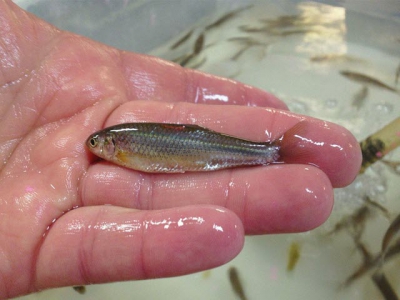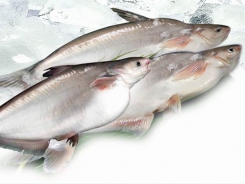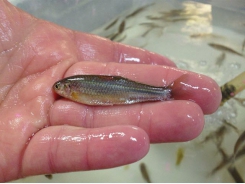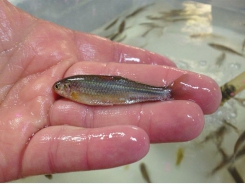How to Farm North African Catfish - Part 3

Feed Supply
Typically, the individual (fed singly) industrial by-products used in pond culture that have been mentioned previously include rice bran, wheat middling, cottonseed meal, corn meal and peanut (groundnut) meal. Farm-made pelleted feeds, typically 28-35 percent protein, consist of various combinations of these by-products, together with other ingredients such as brewery drafts, cacao husk, coffee pulp and chicken droppings. When the ponds are well fertilised, such unusual plant proteins have been used at up to 20 percent of the compounded feed without significant deleterious effects on fish production. Very little, if any, animal protein (e.g. fish meal, blood meal) is currently employed in grow-out feeds for African catfish in fertilised ponds. Other farm-made feedstuffs include maggots, termites, earthworms and crickets.
When requested, national and international feed companies provide specifically formulated catfish feeds. These are mostly used in concrete, fibreglass and plastic tanks as in-line ponds and raceways. The best growth rate and FCR are achieved with diets containing 35-42 percent crude protein and 12 kJ/g feed.
With the current development of recirculation systems balanced sinking fish pellets are not ideal. Extruded feeds that float cause less pollution and are more efficient. However, successful African catfish production in intensive systems is currently closely correlated with imported extruded feed from Europe and Brazil. Efforts are currently being made to establish extruded feed plants in many African countries (e.g. Nigeria and Uganda).
Harvesting Techniques
African catfish ponds are partially harvested using hauling seines. At this time fish are manually sorted; those that appear significantly larger than average are separated and stocked separately to prevent cannibalism. At the end of the rearing cycle ponds are completely drained and the pond bottom cleaned in order to catch all the fish hidden in the mud. Ponds should be dried between production cycles or carefully inspected to prevent huge levels of cannibalism by any escaped adult catfish on the newly stocked fingerlings of the following cycle. Partial harvests of tanks, raceways and recirculation systems are accomplished with grader bars to remove the largest fish.
Handling and Processing
Handling live African catfish is easy because, as long as the skin remains wet, they can stay alive for many days out of water. Harvested fish are loaded live into hauling pick-ups and taken to city markets. The fish are either sold directly to consumers or most frequently to female retailers (bayam-sellam). In the latter case, fish are loaded into 40 litre containers or in bags before transportation using ordinary passenger or merchandise buses. A minority of producers process the fish before they are sold. Depending on fish size and market demand, the fish may be steaked; filleted; or sold headed, gutted, and skinned. Male African catfish exhibit the best dressing and fillet percentage. Compared to other species, C. gariepinus are low in lipid and consequentially have no intense flavour (smell and taste). Smoked African catfish are also in high demand be because they can be stored for longer periods without power while retaining nutritional quality.
These fish are remarkably resilient. In kitchens and restaurants, inexperienced cooks may be frightened by African catfish that remain alive, since they may jump out of the refrigerator many hours after being placed in them! Spreading some ground salt on the skin may kill the fish in a few minutes; using vinegar to soak the skin also allows better spicing and cooking of the fish. In the Cameroon a black soup (bongo) is specifically adapted to make a very tasty stew using a fresh African catfish.
Production Costs
African catfish can be produced most economically in tropical and subtropical countries, which have favourable temperatures for growth as stated earlier. Production costs in these countries vary from USD <1.0/kg to USD 2.5/kg, depending on the production system. Local demand remains high in most of the producing countries and the fish are generally sold in live fish markets, where higher prices can be obtained. In sub-Saharan Africa, market prices range from USD 2.5-5.0/kg; smoked dried fish commanding higher prices.
Considering the typical catfish polyculture systems in Cameroon ponds, feed and fertilisers account for 54 percent of production costs in peri-urban farms but only 22 percent in rural areas, where the cost of fingerlings and labour are the major items. In recirculation systems, feeds and infrastructure maintenance constitute the major production costs. In grow-out tanks, feed constitutes 75-85 percent of the production costs and needs to be carefully managed to ensure commercial success. In Nigeria, the success of these systems is certainly related to the relatively low cost of fuel to run generators (less than USD 0.4/litre of premium petrol in 2010).
The production costs for African catfish farming in recirculation systems tend to be higher in tropical than in European countries because of the current need to import suitable feeds and equipment.
Diseases and Control Measures
African catfish are subject to a wide variety of diseases including bacteria, fungi and miscellaneous parasites. Some of the most important disease organisms are included in the table below, though many of the observed diseases are yet to be fully diagnosed.
| In some cases antibiotics and other pharmaceuticals have been used in treatment but their inclusion in this table does not imply an FAO recommendation. | ||||
| Disease | Agent | Type | Syndrome | Measures |
| Broken head | Unknown | Skeletal deformities (lardosis and scoliosis); fish suddenly stop feeding, become lethargic and die with swollen weak tissues on both sides of the head; usually observed on fish >10 cm; dead fish exhibit thick and curved skulls testifying former lateral crack | Provide supplemental Vitamin C in feeds | |
| Ruptured intestine syndrome | Unknown | Lethargic behaviour; swollen abdomen; discoloured abdominal skin; reddish anal area; rupture of the abdominal wall at the final stage | Provide sufficient balanced and well conserved diet | |
| Ulcerative disease | Unknown | Skin ulceration; sluggish behaviour; red or white necrotic skin ulcers on the mandible and maxilla and on the caudal peduncule | Proper management system | |
| White spot | Myxobacteria | Bacteria | Fish remain at water surface in vertical position and swim sluggishly; white spots on skin around the mouth and gills | Antibiotics in feed (chloramphenicol, terramycin or oxytetracycline) as preventive measure; subject catfish larvae to furaltadone at 50 ppm/hour |
| Aeromonas septicaemia | Aeromonas hydrophila | Bacteria | Fraying and reddening of fins; de-pigmentation; ulcers | Oxytetracycline; sulfamethoxine; ormetoprin in feeds |
| Motile Aeromonad Septicaemia | Aeromonas sp. | Bacteria | Exophthalmia and distended abdomen; deep dermal ulcers with haemorrhages and inflammation | Avoid stress; use supplemental feed mixed with Trimethoprim and Bactrim for 10 days |
| Water mould | Saprolegnia spp. | Fungi | Grey/white patches on skin, fins, gills and eyes resembling cotton-wool; affected eggs show the same signs; normally small, focal infections spreading rapidly over body or gills | Malachite green bath (5 mg/litre for one hour) or sodium chloride (5% for one to two minutes); avoid mechanical damage and other kinds of stress |
| Parasites | Costia sp., Chilodonella, Trichodina | Protozoans | Fish remain at water surface in vertical position, or nervously scratch the head and side on container bottom; skin covered with a thin whitish grey mucus; massive death can occur | Formalin (25-50 mg/litre); Dipterex (0.25 mg/litre) |
| Parasites | Gactylogyrus sp. Gyrodactilus sp. | Trematodes | Same as protozoans above | Formalin (25-50 mg/litre); Dipterex (0.25 mg/litre) |
| Parasites | Henneguya sp. | Protozoans | In fingerlings of C. gariepinus x Heterobranchus sp. hybrid, white spots on skin and gills observed | Antibiotics in feed (chloramphenicol, terramycin or oxytetracycline) as preventative measure |
| Parasites | Cysticerca sp. | Nematode worms | Worm perforates muscled and viscera; usually found in reservoirs; fish appear not to suffer from presence of this parasite | Unknown |
| Gill and/or external parasites | Trichodina maritinkae | Protozoans | Small white spots on skin or gills; irritation, instability, lethargy, weakness, loss of appetite, and decreased activity; gills pale and very swollen | Formalin or salt solution bath |
Most of the diseases listed above are principally observed within intensive culture. Prevention through avoidance of stress is probably the most effective means of avoiding diseases. So far, virus related diseases have not been reported in African catfish. Chemicals are only used when an epizootic has been detected, and then only for limited periods of time.
Related news
Tools

Phối trộn thức ăn chăn nuôi

Pha dung dịch thủy canh

Định mức cho tôm ăn

Phối trộn phân bón NPK

Xác định tỷ lệ tôm sống

Chuyển đổi đơn vị phân bón

Xác định công suất sục khí

Chuyển đổi đơn vị tôm

Tính diện tích nhà kính

Tính thể tích ao



 How to Farm North African Catfish - Part…
How to Farm North African Catfish - Part…  How to Farm North African Catfish - Part…
How to Farm North African Catfish - Part…